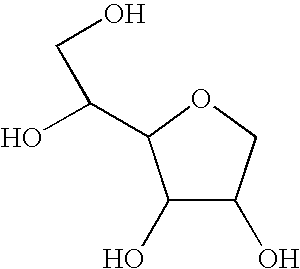Method of drying an absorbent polymer with a surfactant
a surfactant and absorbent polymer technology, applied in the field of absorbent polymer drying, can solve the problems of poor insufficient utilization of dryer capacity, mechanical problems, etc., and achieve the effects of improving pumpability and spreadability, increasing drying efficiency of absorbent polymer, and increasing the acid value of surfactan
- Summary
- Abstract
- Description
- Claims
- Application Information
AI Technical Summary
Benefits of technology
Problems solved by technology
Method used
Image
Examples
example 1
[0040] 4 parts of Pentaerythritol Triallyl Ether are added to 800 parts by weight of acrylic acid. This mixture is then diluted with 2236 parts by weight of DI water and placed into an insulated reactor. Additionally, a surfactant is also added to the insulated reactor. More specifically, T-MAZ® 20 ethoxylated sorbitan monolaurate surfactant is used, and 0.8% by weight lauric acid, based on the weight of the T-MAZ® 20, is added to the T-MAZ® 20 to increase the acid value of the T-MAZ® 20 from about 0.6 mg KOH / g to about 2.5 mg KOH / g. About 0.2% by weight of the T-MAZ® 20 is then added to the reactor. Nitrogen is then blown through the reaction mixture to reduce the dissolved oxygen content to 1 ppm or less. The temperature of the reaction mixture is controlled at 10° C. The following initiators are added in the sequence stated: [0041] 0.008 parts by weight of ascorbic acid; [0042] 0.016 parts by weight of a 35% by weight aqueous hydrogen peroxide solution.
[0043] After an induction ...
example 2
[0046] An absorbent polymer is prepared in the same way as described above in Example 1, except that instead of about 0.8 parts fine grains per 10 parts of mechanically comminuted polymer, about 0.85 parts fine grains are mixed into 10 parts of the mechanically comminuted polymer. The mechanically comminuted absorbent polymer is conveyed through the pipeline again with the aid of the pump at a pump pressure of 35 bar. In this case, the pump pressure of 35 bar establishes a rate of conveyance of 6607 kg / h per drum dryer. The benefit that is gained by the higher pump pressure is that although no substantial change in overall efficiency results when compared to Example 1, wherein the polymer is conveyed at the pump pressure of 30 bar, the drying rate is increased due to higher active polymer solids contained in the polymer that is fed through the pipeline to the drum dryer.
example 3
[0047] An absorbent polymer is prepared in the same way as described above in Example 1, except the lauric acid is not added to the T-MAZ® 20. Instead, the T-MAZ® 20, as manufactured, is allowed to hydrolyze by storing the T-MAZ® 20 for a period of about 3 years. Due to hydrolysis, the acid value of the T-MAZ® 20 is increased from about 0.6 mg KOH / g to about 2.5 mg KOH / g. In this case, a pump pressure of 31 bar establishes a rate of conveyance of about 6440 kg / h, and spread distance is about 9.0 cm.
PUM
| Property | Measurement | Unit |
|---|---|---|
| acid value | aaaaa | aaaaa |
| surface temperature | aaaaa | aaaaa |
| temperature | aaaaa | aaaaa |
Abstract
Description
Claims
Application Information
 Login to View More
Login to View More - R&D
- Intellectual Property
- Life Sciences
- Materials
- Tech Scout
- Unparalleled Data Quality
- Higher Quality Content
- 60% Fewer Hallucinations
Browse by: Latest US Patents, China's latest patents, Technical Efficacy Thesaurus, Application Domain, Technology Topic, Popular Technical Reports.
© 2025 PatSnap. All rights reserved.Legal|Privacy policy|Modern Slavery Act Transparency Statement|Sitemap|About US| Contact US: help@patsnap.com



